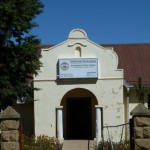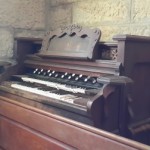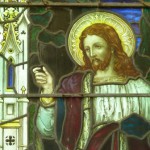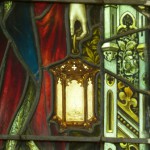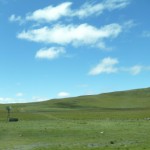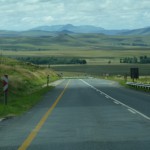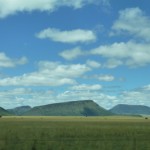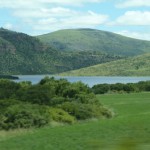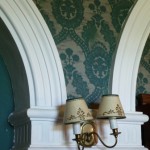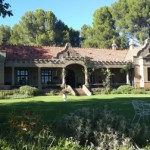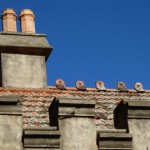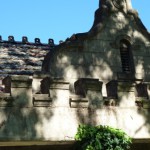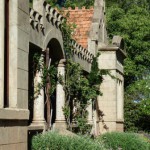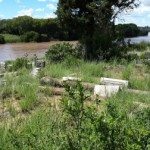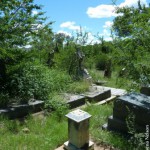Shrouded
To his credit, dear Mr Wessels shows no signs of accepting defeat just yet. I realise that the exercise book he has with him lists the graves in each plot by row number, so I suggest he look up some of the names we are seeing on the graves to check whether we are indeed in the correct place. Mmm – it seems as though we are in row 10. We move back one row and work our way slowly back up it, checking the names on the graves with those in his book. Now we seem to have passed the place where Aunt Minnie’s grave ought to be. We look around, surveying bits of broken headstones. Behind me, I notice a strip of white under a rampant daisy of sorts. It’s the edge of a grave, and a cactus stands guard at the foot of it. There is no sign of a headstone, just the flourishing mass of a creeping bush with shiny green leaves. I turn and look at it. Swallowing my fear of snakes, I start to push it back. Mr Wessels goes around to the other side of the grave and does the same. And there, underneath that leafy shroud, we discover Aunt Minnie’s headstone, just as my Mum joins us. For a moment, we just stand there, almost in disbelief. Then we thank Mr Wessels for taking time out from his busy day to help us. Reverently, sympathetically, he observes, “Sy was nog jonk, net ses-en-twintig,” then bids us farewell. In a few seconds, he’s gone, although we hear him chatting briefly to my Dad who’s waiting in the car.
My mother and I clear a little more of the vegetation away from the grave. Three simple blocks of white stone (marble?) are stacked on top of one another, each a little smaller than the one below. The top one seems to have had concrete roughly squished around it, presumably to keep it in place. While the job is not well done, I am grateful to the person who sought to preserve Aunt Minnie’s name on her grave. It is evident, too, that something is missing from the top block – ornamentation of some sort which has long since broken off. I never met Great Great Aunt Minnie. A few months ago, I didn’t even know I had a Great Great Aunt Minnie. Yet, standing there, I’m surprised by the emotions I’m feeling. There is a yearning to tend the grave of this lady I know so little about. There is sadness at the loss of a young life, young wife and young mother. Yet there is also a sense of joy and peace that we persevered in finding her resting place, that while she may be gone, she is indeed now not forgotten. Pensive, we return to the car, and then find our way back onto the N6, bound for Grahamstown.
A Jamestown Jewel
It’s a beautifully clear day and the scenery is stunning – mostly farmland. I’m again reading out snippets about the tiny towns on the route as we approach them. Less than an hour outside of Aliwal North, we drive through Jamestown, and then realise we’re about to pass the church I’ve just read about: the Kidwell Memorial Church. My mother and I squeak at the sight, and my father obligingly pulls over. It’s a small, attractive, stone structure, with something resembling a mini-steeple on top of it, which looks as though it may have melted and now leans to one side. The cleaning staff outside don’t have a key, but bush telegraph works a treat, and a few minutes later, somebody appears with one. It doesn’t, however, seem to help much, because it still sounds as though they have to break in to gain access! The petite foyer is illuminated by sunlight filtering through the stained glass windows. Sandwiched between the back wall of the sanctuary and the last wooden pew is an old organ – strong, silent and battle-scarred. More stained glass windows, each set of them different, line the side walls, and to the left and right of the pulpit, above the windows, are little sections of ornate pressed ceilings. It is a place full of character, a place of peace, but it’s suddenly becoming a little less peaceful, as a couple of curious locals have arrived on the scene, doubtless hearing about the “tourists” in town!
On the Road Again
Shortly after leaving Jamestown, we see a sign to Burgersdorp. We’re going to spend the last part of our holiday there, where Granny Iris was born, hence the relevance. A little while later, we see another sign, and then another, at which point my father and I exclaim almost simultaneously, “All roads lead to Burgersdorp!”
The landscape is still breathtaking, though it’s now starting to morph from farmland into mountain ranges, a reminder that we really do live in a country of incredible diversity and beauty. In Queenstown, boards advertising the Dew Drop Inn and the appropriately-named Number Two Piggeries remind us that there is no shortage of wit here, either! We decide to leave the N6 and take the R67 from Queenstown to Grahamstown. Whittlesea and Seymour make cameo appearances along this route, and it’s somewhere between Seymour and Fort Beaufort that we stop at a lay-by for a quick lunch of pies and cherry tomatoes and to stretch our legs.
Henri House
Just after 15:00, we see Grahamstown unrolling before us. Astonishingly, it looks as though we’re driving on the edge of a municipal rubbish dump rather than a hip, arty cultural hub. Rubbish is strewn about the streets and banked up against the curb, and I’m wondering what I’m about to subject my long-suffering parents to. Fortunately, by the time we make our way onto Hill Street, past the Cathedral, things become much more pleasant, and I relax a little.
Madame GPS expertly guides us to Henri House where we will spend the next three nights. I ring the gate bell and Chiara appears, a toddler on her hip and a little boy attached to her leg. We make our introductions and she disappears briefly. When she returns, the boy has detached himself and is tentatively walking toward me with the keys for our unit, delightfully explaining where we need to go and what we need to do. I double-check some of the instructions with Chiara, and then return to the car.
We unpack and get ourselves settled in, which includes checking the DStv channels for my father (“There’s rugby on tomorrow, you know!”). We discover that we can only get SABC, so my mother and I meander out into the garden to “call for help”. As we’re about to walk around to the front of the main house, the side gate opens and a gentleman pulls in on a scooter. He clearly sees we’re looking a little unsure and asks if he can help. His name is Andrew, and he’s just returned from work (teaching at a local school), but seems to be co-owner/manager of Henri House, so we relate our woeful tale and are amazed when he gets straight off his scooter and immediately comes to investigate. After fiddling with the remote, decoder and TV for a few minutes, he discerns that the problem will take a little longer to fix and says he will look into it tomorrow for us.
We do, though, discover that the TV has a USB port, so I download the photos we’ve taken over the last two days onto my laptop and then copy them onto a flash drive. We spend a wonderful evening reviewing our journey down in pictures, and put a brief plan of action together for the next couple of days. After a light supper, we decide to call it an early night. The time to curl up in bed and read before falling asleep is a holiday luxury I crave, so I take full advantage and am soon immersed in my book, in other places, in another time, until sleep eventually takes over and I drift off into dreams…






